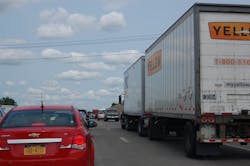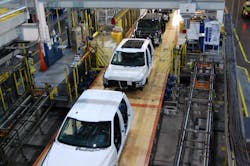Of traffic congestion and plateauing light vehicle sales
It’s been quite a stretch where motor vehicle news is concerned.
The grim analysis from the National Safety Council (NSC) is perhaps the most startling; that U.S. highway fatalities reached a nine-year high in 2016 with some 40,200 killed.
Then there’s the “connected vehicle” technology rulemaking announced by the Department of Transportation (DOT) late last year; one that’s designed to help foster the wider deployment of autonomous vehicles.
Now comes word that congestion cost U.S. drivers nearly $300 billion in 2016, or an average of $1,400 per driver, according to a new report compiled by Inrix.
Inrix’s Global Traffic Scorecard analyzes and ranks the impact of traffic congestion in 1,064 cities across 38 countries worldwide and found that (surprise, surprise) Los Angeles tops the list of the world's most gridlocked cities, with drivers spending 104 hours in congestion last year during peak time periods, followed by Moscow (91 hours), New York (89 hours), San Francisco (83 hours) and Bogota (80 hours).
Unfortunately, the company’s data indicates that the U.S. accounted for 11 of the top 25 cities worldwide with the worst traffic congestion, while our nation is tied for fourth in the world with the highest average hours spent in peak traffic congestion (42), behind only Thailand (61 hours), Columbia and Indonesia (both tied at 47 hours).
[We’re tied with Russia, of all countries, at 42 hours; oh the irony, especially in light of all the political wrangling of late!]
Here are a few more data points from Inrix’s congestion study where U.S. drivers are concerned breakdown:
- Average Direct Cost per Driver: $1,210.84
- Average Indirect Cost per Driver: $188.91
- Average Total Cost per Driver: $1,399.75
- Number of Cars in the U.S.: Just over 210.7 million
- Total Cost of Congestion for the U.S.: Just over $295.03 billion
“Traffic truly is a double-edged sword," he added. "The demand for driving is expected to continue to rise, while the supply of roadway will remain flat. Using big data and technology to improve operations of existing roadways offers a more immediate impact on traffic flows and mobility [as] transportation officials explore strategic capital investments."
Meanwhile, as that “targeting” begins to take shape, we seem to be hitting a “plateau” of sorts where global light vehicles sales are concerned – at least according to data tracked by IHS Markit.
The firm predicts that total 2017 global light vehicle sales will reach 93.5 million units, a growth rate of 1.5% over 2016, but IHS cautions that “industry risk” in mature markets is at the highest level it has been since the “Great Recession” of 2008, with “political uncertainty” in the U.S. and Europe adding more volatility to the mix where vehicle sales are concerned, added Henner Lehne, senior director for the global vehicle group at IHS Markit.
“This could cause a significant rift in light vehicle sales both in the U.S. and Europe, as both regions are undergoing fluctuations in policy, leadership and other dynamics,” he explained.
Where the U.S. is concerned, automotive sales lost some momentum so far this year, Lehne noted, with policies and changes proposed by the Trump administration regarding trade and environmental regulations creating “some uncertainty” that is offset to a degree by “a slightly improved economic picture” for 2018 through 2021.Still, he noted that it is “difficult and unlikely” that the pace of U.S. light vehicle sales will continue at the same rates seen over the past eight years.
Lehne believes a “leveling off” is underway, with IHS Markit forecasting U.S. light vehicle sales in 2017 to be “unchanged” at 17.4 million units, a slight moderation on 2016 levels, down just 1%.
Here are a few other tidbits from IHS Markit’s light vehicle outlook:
- The firm forecasts a decline of diesel vehicle sales market share in Europe for 2017, which will further accelerate more than the European light vehicle market has experienced in the last decade. This represents just the start of a growing trend of diesel decline expected in the coming years, due in part to significant challenges around RDE regulation alongside the arrival of the EU6d emission standards.
- Despite the daily publicity, sales of BEVs (battery electric vehicles) and PHEVs (plug-in hybrid electric vehicles) light vehicles were relatively flat between 2015 and 2016, despite the ever-present “longer-term growth fundamentals.” Global BEV production remains significantly below one million units and will represent just 0.7% of new vehicle supply globally in 2017, the firm said.
- So-called “mature markets,” such as the U.S. and Western Europe, together with China, were key to overall light vehicle sales growth in 2016, according to IHS Markit, with provisional 2016 year-end total industry volumes set at 92.1 million units globally, up 4.6%.
- Looking forward, the firm expects China to continue to be the world’s largest car market for the foreseeable future, and has upgraded its 2017 China forecast to 28 million units (up 1.9%) and expected payback effects will now be in play for 2018 (slipping 0.8%). Provisional figures analyzed by IHS Markit suggest that China accounted for approximately 76% of the 2016 volume growth in global auto sales.
Tell you one thing: 2017 is not going to be a boring year where the light vehicle market is concerned.


